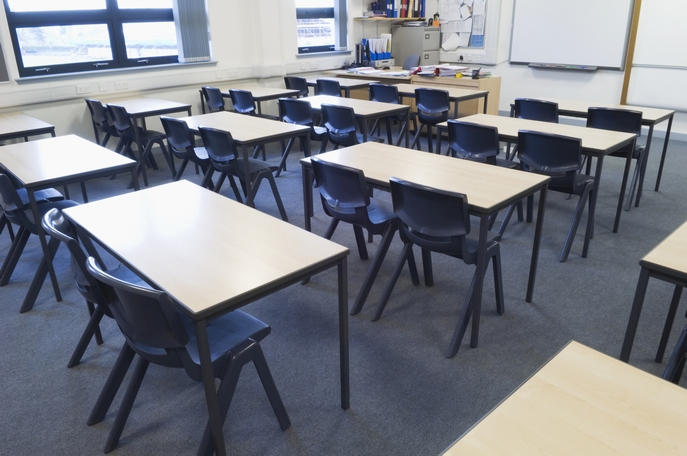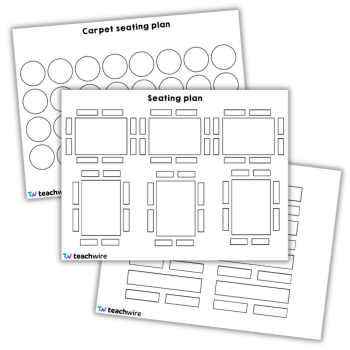PowerPoint (editable) and PDF seating plan templates
KS1, KS2, KS3, KS4
Years 1-11
Seating plan download
This download contains editable PowerPoint templates to help you set out a seating plan for your classroom. Choose from table clumps, tables in rows or our carpet positions plan.
All you need to do is edit the tables to match your classroom, if necessary, then type in pupils’ names. There are also PDF versions if you’d prefer to print out the templates and fill them in by hand.
Is your seating plan undermining learning?

Seating plans may be a great way to learn students’ names, keep order and establish routine, but the truth is, they might actually be undermining children’s ability to learn, explains David Didau…
Ideally, we want our students to go off into the world and flourish; transferring all the fascinating stuff we’ve taught them to new and exciting contexts. In practice it’s impossible to know whether this actually happens, so we tend to settle for transfer from the context of the classroom to the context of the exam hall.
This is harder than you might imagine. Memory is context-dependent. We tie the acquisition of new ideas to what we already know in visual and emotional contexts.
Environmental impact
The context in which we first encounter an idea creates contextual cues. They are the visual and autobiographical memories on which we hang new ideas.
Psychologists have run experiments that involve playing particular genres of music, or inducing particular emotional states, and then testing participants in conditions which either share or don’t share those conditions to demonstrate the power of contextual cues in increasing retention.
This would be great if we could exactly recreate the conditions in which we learned when taking a test. However, we struggle to transfer what we know into different contexts where cues are absent.
The variation effect
But by varying the conditions in which we learn, maybe we can break our dependence on context cues? Smith, Bjork and Glendale’s 1978 paper, “Environmental context and human memory” was probably the first attempt to explore how we might do this.
They gave participants a list of words to learn and had them study either in the same room twice, or in two separate rooms – one a cluttered basement, the other a windowed office.
Three hours later, they bundled the students into a third ‘neutral room’ and asked them to recall as many of the words as they could.
Those who studied in the same room managed an average of 16 out of 40 whereas those who studied in two different rooms recalled 24 words. The experiment “showed strong recall improvements with variation of environmental contexts.”
This latterly became known as the ‘variation effect’, and since then there have been many other studies that have further investigated and built on this research.
The implication for schools is clear. If we want students to perform at their best in the exam hall, we should vary the conditions in which we teach them. Ideally, we might give every lesson in a new room to prevent students from tying memories to specific contexts. However, this would be both impractical and annoying.
We could perhaps timetable each lesson in a given week in a different classroom, but this would be only slightly less problematic.
“If we want students to perform at their best in the exam hall, we should vary the conditions in which we teach them”
As an individual teacher, it seems there’s little you can do with this information unless you can persuade the chap next door to swap with you now and again.
Varying your seating plans
One workable solution is to vary seating plans as much as possible. A few years ago I became aware of a very strange, and as far as I know, unresearched phenomenon. If I taught a lesson where students knew something in that chair, they would not necessarily know it in this chair.
Simply asking students to move seats in the middle of a lesson was enough to disrupt their ability to recall something.
“One workable solution is to vary seating plans as much as possible”
Memory can be more brittle and fragile than I would have thought possible. If a student spends a term or a year sitting in the same seat every lesson, then they will see the same things every lesson. And if they sit next to the same students each lesson, they will become used to a particular emotional context.
It’s not too great a stretch to say that students will become dependent on those strong visual and emotional cues. If learning is tied to these cues, then when the ties are severed the learning often seems to unravel.
Shaking it up
So I started experimenting with moving students about and giving them a greater variety of sight lines. They also experienced different emotional responses to being seated next to different students, thus creating a greater and less stable range of contextual cues.
And guess what? Their ability to transfer what they’d learned within the classroom improved.
“I started experimenting with moving students about and giving them a greater variety of sight lines”
Now, I would, of course, hesitate to make a mountain out of this molehill, but this does seem worthy of further investigation.
My tentative advice is not to throw away your seating plans, but to have more of them. It might seem inefficient to have a different plan for each class each lesson, but maybe you could design a plan where each student moves two seat to their left (or something similar) for each session.
If you’re prepared to put up with some short-term disruption for a long-term gain, the pay-off might be that students learn more.
David Didau is an independent education consultant and writer. He blogs at learningspy.co.uk, and is the author of several books, including The Secret of Literacy and What Every Teacher Needs to Know About Psychology. Follow him at @DavidDidau.














